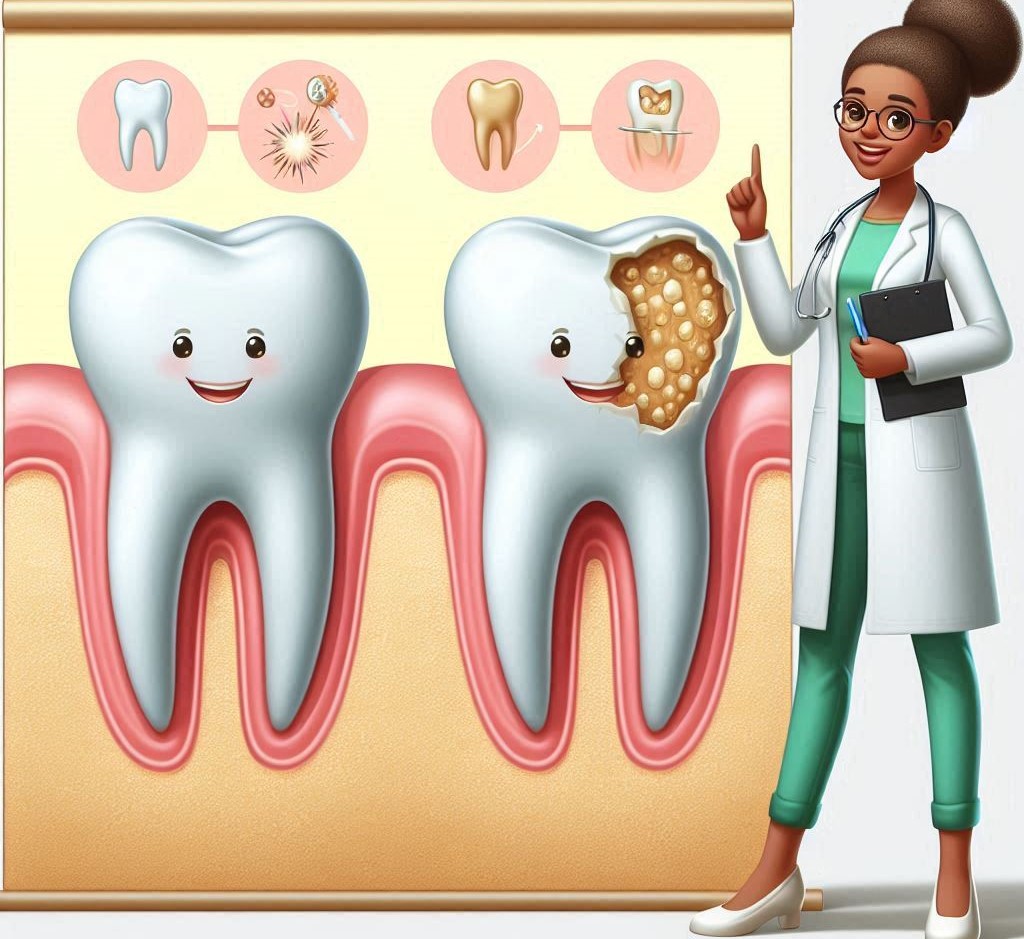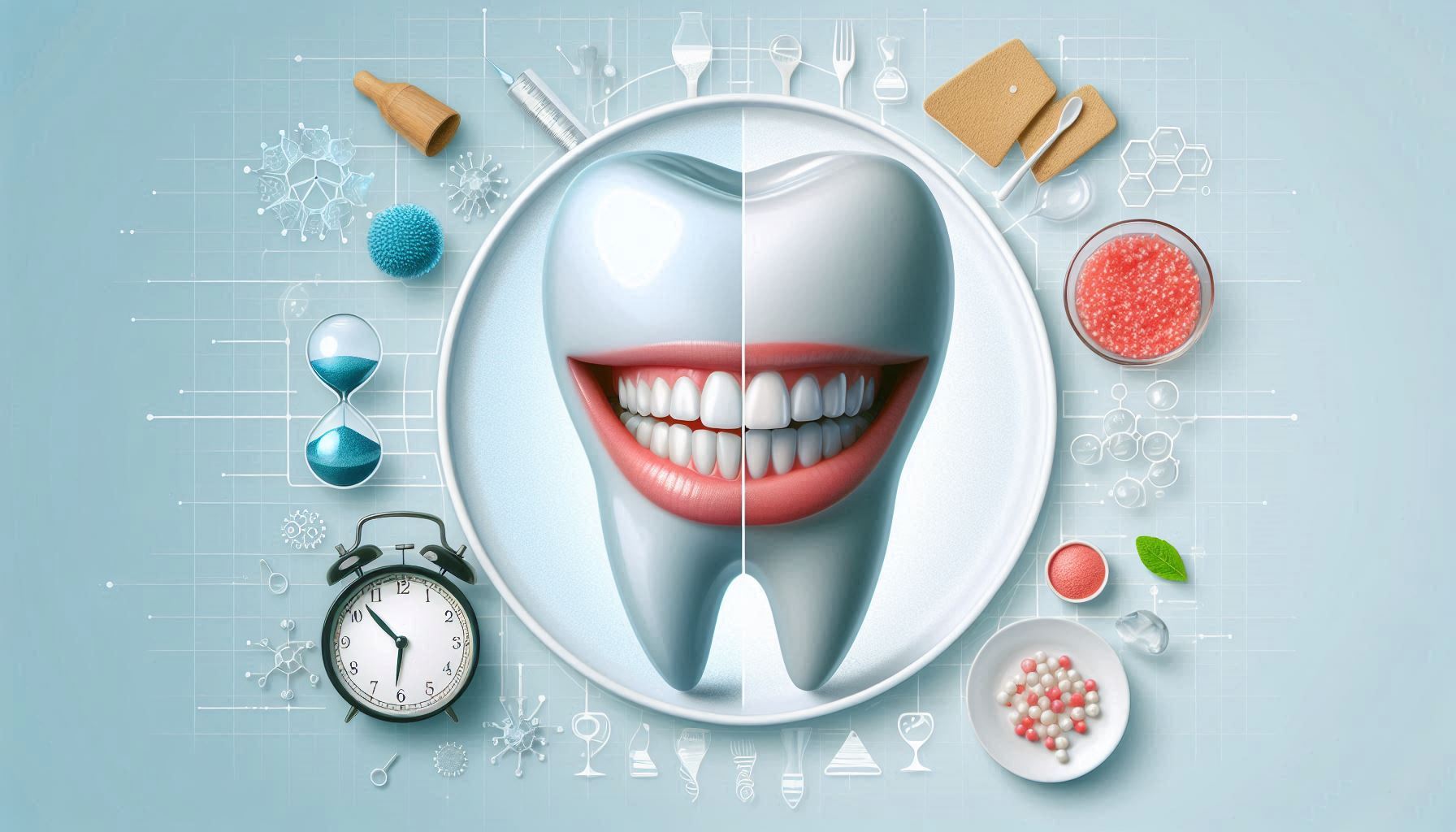Dental cavities are one of the most prevalent health issues worldwide, affecting individuals of all ages. Despite the availability of preventive measures and advanced treatments, cavities continue to be a widespread problem, often resulting in severe complications if left untreated. Understanding the process of cavity formation, its impact on oral and systemic health, and the importance of early detection can make a significant difference in preventing more severe consequences. In this detailed exploration, we will delve into what happens if a cavity is left untreated, the stages of cavity progression, and why early detection is crucial for maintaining overall health.
What is a Cavity?
A cavity, also known as dental caries or tooth decay, is a hole or damage to the hard outer surface of a tooth caused by the erosion of tooth enamel. The enamel is the tooth’s protective outer layer that shields the inner, more sensitive parts of the tooth from bacteria, acids, and other harmful substances. Over time, bacteria in the mouth break down sugars from food and drink, producing acids that dissolve the minerals in the enamel, leading to the formation of cavities.
Cavities can form anywhere in the mouth but are most common on the chewing surfaces of molars, between teeth, and along the gumline. The severity of a cavity can vary depending on the stage at which it is discovered. If cavities are detected early, they are relatively simple and inexpensive to treat. However, when they go undetected or untreated, the damage to the tooth can become irreversible, and the treatment required becomes far more extensive.
Stages of Cavity Development
The development of cavities occurs in stages, each stage representing a different level of damage. Understanding these stages helps us appreciate the importance of early detection, as treatment becomes increasingly complex as the decay progresses. The stages are as follows:
1. Initial Demineralization
In the earliest stage of tooth decay, the enamel begins to lose its mineral content due to the acids produced by bacteria in the mouth. This process is known as demineralization. At this stage, the damage is typically microscopic, and there is no visible hole or cavity. The enamel may appear slightly chalky or dull, and the tooth may become more susceptible to sensitivity. However, there are often no noticeable symptoms, so many people do not realize they have early-stage decay.
In some cases, the enamel may begin to remineralize if good oral hygiene is practiced, such as brushing with fluoride toothpaste or using fluoride mouth rinses. Fluoride helps restore lost minerals to the enamel, potentially reversing the damage before a full cavity forms.
2. Enamel Decay (Visible Cavities)
If demineralization continues and is not addressed, the enamel becomes more porous, and small holes may begin to form. This is the first stage where a cavity becomes visible. At this point, the damage is confined to the enamel, and the underlying dentin (the layer beneath the enamel) remains unaffected.
In many cases, the cavity at this stage will not cause significant pain or discomfort. However, a person may start noticing sensitivity when consuming hot, cold, or sugary foods and drinks. This is because the protective enamel layer is compromised, and stimuli can reach the sensitive dentin layer beneath.
3. Dentin Decay
If a cavity continues to progress without treatment, it reaches the dentin, which is softer and more susceptible to decay than enamel. Dentin contains nerve endings, and when bacteria reach this layer, the tooth becomes more vulnerable to pain and sensitivity. At this stage, the cavity is deeper and requires more advanced treatment, such as a filling.
The pain and sensitivity can become more pronounced during this stage, particularly when the tooth is exposed to temperature changes or pressure from chewing. Additionally, the tooth may begin to change color, often turning brown or dark yellow.
4. Pulp Infection (Abscess Formation)
If the cavity continues to deteriorate and the infection spreads further into the tooth, it reaches the pulp, which is the innermost part of the tooth. The pulp contains blood vessels and nerve endings and is highly sensitive. Once bacteria reach the pulp, they cause an infection that can lead to severe pain, swelling, and the formation of an abscess, which is a pus-filled pocket that develops at the root of the tooth.
An abscess can cause intense pain, swelling of the surrounding gum tissue, and sometimes fever or a general feeling of illness. The infection can spread beyond the tooth, affecting nearby tissues, bone, and even the bloodstream, leading to more serious complications. In these cases, a root canal may be necessary to remove the infected pulp and save the tooth. Without treatment, the infection can lead to tooth loss and more widespread health problems.
5. Tooth Loss
When a cavity is left untreated for a prolonged period, the tooth may become so structurally compromised that it can no longer be saved. At this point, the tooth may fracture, or the infection may spread to the surrounding bone, leading to tooth loss. A severely decayed tooth may need to be extracted if it cannot be repaired through a root canal or other restorative procedures.
Tooth loss has significant consequences beyond aesthetic concerns. Missing teeth can affect your ability to chew properly, leading to digestive issues or malnutrition. Furthermore, the loss of a tooth can cause nearby teeth to shift, resulting in alignment problems, bite issues, and further complications down the line.
Consequences of Leaving a Cavity Untreated
Leaving a cavity untreated can lead to a variety of serious consequences. These consequences can affect not only the tooth itself but also your overall health and well-being. Let’s take a closer look at the major risks associated with untreated cavities.
1. Increased Pain and Discomfort
One of the most immediate effects of an untreated cavity is an increase in pain and discomfort. As the cavity progresses, the damage to the tooth becomes more severe, and the nerve endings within the pulp become exposed to bacteria and other stimuli. This can cause sharp, throbbing pain, particularly when the tooth is exposed to hot, cold, or sweet foods and drinks.
The pain can become constant and debilitating, making it difficult to focus on daily activities. In some cases, the pain may radiate to other areas of the face or jaw, further complicating matters. This level of discomfort can significantly impact your quality of life and may require emergency dental treatment to address.
2. Infection and Abscess Formation
Perhaps the most serious consequence of leaving a cavity untreated is the risk of infection. As the cavity progresses to the pulp, bacteria can invade and cause an infection that leads to abscess formation. An abscess is a pus-filled pocket that forms at the root of the tooth. Abscesses can cause severe pain, swelling, and fever, and may require urgent treatment to drain the infection and prevent it from spreading further.
If an abscess is not treated, the infection can spread to surrounding tissues, including the gums, jawbone, and even other parts of the body. In severe cases, untreated infections can lead to systemic conditions like sepsis, a life-threatening response to infection that requires immediate medical attention.
3. Tooth Loss
Tooth loss is one of the most significant consequences of untreated cavities. As the decay progresses, the tooth may become so damaged that it is no longer salvageable, requiring extraction. Tooth loss not only affects your ability to chew and speak properly but can also have long-term effects on your overall oral health.
When a tooth is lost, the surrounding teeth may begin to shift out of alignment, leading to bite issues and potential damage to neighboring teeth. Additionally, missing teeth can cause bone loss in the jaw, as the bone no longer receives stimulation from chewing. This can make it more difficult to place dental implants or other restorative treatments in the future.
4. Damage to Surrounding Teeth
Untreated cavities do not only affect the decayed tooth. Bacteria from the cavity can spread to neighboring teeth, leading to additional cavities and decay. This process can create a cascade effect, where one untreated cavity leads to multiple dental issues in different parts of the mouth.
Furthermore, untreated cavities can alter the way you bite and chew, causing additional strain on other teeth. The misalignment can lead to uneven wear on your teeth, increasing the risk of further damage.
5. Systemic Health Complications
Oral health is closely linked to overall health. Untreated cavities and infections can have systemic effects that extend beyond the mouth. Research has shown that bacteria from oral infections can enter the bloodstream and travel to other parts of the body, contributing to serious conditions such as heart disease, stroke, diabetes, and respiratory infections.
For individuals with weakened immune systems, such as those undergoing chemotherapy or individuals with diabetes, untreated cavities can exacerbate health problems and lead to complications that may require more extensive medical intervention.
The Importance of Early Detection
The key to preventing the serious consequences of untreated cavities is early detection. When cavities are detected in their early stages, they can be treated with relatively simple and cost-effective procedures, such as fillings. Detecting cavities early can prevent the need for more invasive treatments, such as root canals, crowns, or extractions.
Here are a few important reasons why early detection is crucial:
Prevention of Pain and Discomfort
The sooner a cavity is detected, the less likely it is to progress to the point where it causes severe pain. Early treatment can prevent the discomfort associated with deep cavities, pulp infections, and abscesses.
2. Cost-Effective Treatment
Treating a cavity in its early stages is far less expensive than waiting until the decay has caused extensive damage. Fillings, for example, are relatively inexpensive compared to the costs associated with root canals, crowns, or tooth extractions. By detecting cavities early, you can avoid costly procedures and the need for extensive restorative work.
3. Preservation of Natural Teeth
The earlier a cavity is treated, the more likely it is that the natural tooth can be saved. Preserving natural teeth is important not only for aesthetic reasons but also for maintaining proper oral function. Early detection helps to minimize the damage to the tooth, reducing the need for artificial replacements like crowns or implants.
4. Overall Health Benefits
By addressing cavities early, you can avoid the risk of infection spreading to other parts of the body. Early detection and treatment can significantly reduce the risk of systemic health issues, such as heart disease, diabetes, and infections that can affect your entire body.
Regular Dental Checkups: Routine dental visits are essential for catching cavities before they progress. Dentists have the tools and expertise to identify even the smallest cavities that may not yet be causing pain. Early-stage cavities are often not visible to the untrained eye, and X-rays may be needed to detect decay between teeth or beneath the surface of a tooth.
Fluoride Use: Fluoride is a mineral that helps remineralize weakened enamel and protect it from further decay. Using fluoride toothpaste and drinking fluoridated water can help prevent cavities from forming or halt the progression of early-stage cavities.
Good Oral Hygiene: Proper brushing, flossing, and diet all play a role in cavity prevention. Brushing twice daily with fluoride toothpaste, flossing between teeth, and avoiding sugary foods and beverages can significantly reduce the likelihood of cavities forming.
Sealants: Dental sealants are a preventive measure that can be applied to the chewing surfaces of molars to protect them from decay. Sealants are especially beneficial for children and teens, as their molars are more prone to cavities due to deep grooves and fissures.
Dietary Changes: Avoiding sugary snacks and drinks and incorporating more calcium-rich foods can help strengthen your teeth and prevent decay. Additionally, drinking plenty of water throughout the day helps rinse away food particles and bacteria that contribute to cavity formation.
Conclusion
Dental cavities are a common yet preventable problem, and the risks of leaving them untreated are significant. From increased pain and infection to tooth loss and systemic health complications, untreated cavities can lead to serious consequences that impact not only your oral health but also your overall well-being. Early detection through regular dental check-ups, good oral hygiene, and the use of fluoride can help prevent cavities from progressing to the point where they require invasive treatment.
By prioritizing early detection and treatment, you can avoid the serious complications associated with untreated cavities and ensure that your teeth remain healthy for years to come. Remember, a small investment in regular dental care now can save you time, money, and discomfort in the future. Keep your teeth healthy, and they will keep you smiling!
SOURCES
Bader, J. D., & Summitt, J. B. (2003). Caries prevention and restorative materials in contemporary dental practice. American Dental Association.
Edelstein, B. L. (2002). Dental caries: The impact of social determinants of health. Journal of Public Health Dentistry, 62(4), 254-259.
Fejerskov, O., & Kidd, E. A. (2003). Dental caries: The disease and its clinical management (2nd ed.). Blackwell Munksgaard.
Marsh, P. D. (2003). Dental plaque as a biofilm and a microbial community—Implications for health and disease. BMC Oral Health, 3(1), 2-6.
Pitts, N. B., & Zero, D. T. (2016). Caries risk assessment: A review of the literature. Journal of Dental Research, 95(6), 565-573.
Rosen, S. H., & Epstein, J. B. (2012). The pathogenesis of dental caries: A comprehensive review. Oral Diseases, 18(5), 413-423.
Selwitz, R. H., Ismail, A. I., & Pitts, N. B. (2007). Dental caries. The Lancet, 369(9555), 51-59.
Ten Cate, J. M. (2008). Oral histology: Development, structure, and function (7th ed.). Mosby.
Tinanoff, N., & Reisine, S. T. (2009). Update on the dental caries epidemic and its consequences for oral health. Dental Clinics of North America, 53(3), 497-511.
Weintraub, J. A. (2001). Prevention and management of dental caries: A clinical approach. Journal of Dental Education, 65(5), 437-446.
HISTORY
Current Version
February 28, 2025
Written By:
SUMMIYAH MAHMOOD




